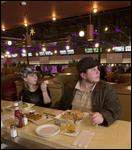 All photos courtesy of Chris LaChall. Pub. Dec. 14 in SJ Scene.
All photos courtesy of Chris LaChall. Pub. Dec. 14 in SJ Scene.The bouncer won't budge, standing between you and a bevy of clubgoers inside the low-lit alley. He checks your style and then your I.D. before shifting sideways to let you through.
If it wasn't clear before, it's strikingly so now: Bowling is no longer just fun and games, but much more at some alleys.
In the last three years, area bar owners have modernized, perhaps even glamorized, a pastime dating back to the Flintstones, setting up luminous bowling lanes in luxurious lounges throughout Philadelphia.
In the last three months, that trend has extended into South Jersey with the opening of Pinsetters Bar & Bowl, allowing "Guys' Night Out" to be bridge-toll free and to start a little earlier. Yabba dabba doo!
Whether they come to the Pennsauken center for the booze, food or rental shoes, bar-restaurant manager Shawn Reilly said its patrons are usually bowled over.
"When they walk in the doors they don't know what to expect," said Reilly, 25, of Philadelphia. "They're in a state of shock that this place got renovated from what it was to what it is now."
As unbelievable as converting a seven-10 split, new owner Mark Platzer spent four months converting the modest Maple Bowl into a palace of pins and pizazz.
Wanting to put a spin on the typical bar scene, the Haddonfield resident flew to Las Vegas to attend a bowling expo in the spring.
"I don't want it to be the traditional bowling alley," Platzer, 45, said. "I want people to enjoy the atmosphere if they don't bowl."
Cinnaminson resident and casual bowler Harry Aydin doesn't want the traditional bowling alley either.
While the modern -- if not new-age -- furniture may intimidate some, when compared to the bare, old-school alleys frequented by the more serious, league-bowling types, it's disarming for Aydin.
"My arm will hurt the next day," Aydin, 28, said, "but at least this atmosphere is nice. If you bowl 140 or 90 it doesn't matter. It's about having a good time."

In a dim setting spared from black lights and disco balls, 34 neon-trimmed lanes each lead to, yes, 10 pins, and to several overhanging projection TVs.
Its new second-floor VIP lounge, usually reserved for bachelor and bachelorette and corporate parties, has a separate bar and overlooks its 10 reserved lanes.
Bowling's look has certainly changed, but so has people's outlook on the sport, said Kannon, an on-air personality at Wired 96.5.
"Dorky is the new cool," said Kannon, 30, an admitted avid bowler from Philadelphia. "I think bowling used to be dorky, but there's a new trend in bowling where it's cool now."
"It's like that nightclub environment, but there's something to do," said Beverly Wojciechowski, 24, of Philadelphia. "There's that competition, a bit of fun, a bit of excitement. It's more than just coming to hang out."
Jason Freeman notices Pinsetters' overhaul more than anyone.
Freeman, who's worked as the head mechanic for the alley for the last two years, said he notices a change in the crowd dynamic.
"We're losing a lot of league bowlers because of the lighting and all that, but the partiers are really picking up," said Freeman, 19, of Maple Shade.
Pinsetters, at 7111 Maple Ave. in Pennsauken, opens its doors to only those 18 or older after 8 p.m. and to legal drinkers after 10 p.m.
Once in, its typical 21- to 45-year-old clientele usually heads for its restaurant or its bar, said Reilly -- and he doesn't mean snack bar.

Offering more than just pizza and burgers, Pinsetters' menu includes penne pasta, strip steak and crab cakes, all on the higher end of a $7 to $19.50 price range.
The full bar boasts a wide selection of martinis ($8), speciality drinks ($7), and a weekday happy hour from 4 to 7 p.m.
An additional "In The Biz" happy hour, falling between 11 p.m. and 2 a.m. on Sunday through Thursday, aims to appeal to the area bartenders and servers who just get done work.
"Usually when a business closes, their staff goes somewhere else," Reilly said.
And business is coming from all directions.
"A place like this doesn't really exist around here," Reilly said. "We're trying to open up a martini bar with a bowling alley. That's what we're doing. It's something to break up the monotony of just sitting on a barstool."
Once suffering from a dearth of decent bowling alleys, Philadelphia has changed lanes, now offering three upscale venues to chose from: Strikes Bowling Lounge in University City, Lucky Strike Lane in Center City and North Bowl in Northern Liberties.
While Strikes was the first boutique bowling center to roll onto the city's scene in January 2005, Lucky Strike is known as the nation's first "bowling lounge," setting up shop in Hollywood and infusing some of that sushi-eating, cocktail-sipping culture in each of its 15 other locations across the country.
Philadelphia's Lucky Strike is no different, casting a club ambience throughout its three tiers while offering a profusion of plasma TVs, plush sofas, top-shelf liquors, and well-done entrees, not to mention its lanes.
Like Lucky Strike, Pinsetters enforces a mild dress code that prohibits sandals and sleeveless shirts.



